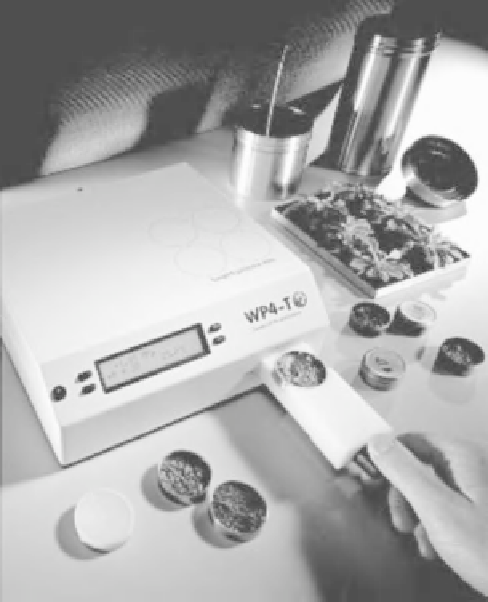Environmental Engineering Reference
In-Depth Information
Table 5.8 Properties of Clayey Silt and Clay Test
Using Desiccator and Chilled-Mirror Device
Temperature
sensor
Fan
Mirror and photo detector
Soil Properties
Clayey Silt
Clay
Liquid limit, %
20.3
81
Soil sample
Sealed chamber
Plastic limit, %
15.1
23.1
Plasticity index, %
5.2
57.9
Figure 5.97
Schematic of WP4 chilled-mirror Water Potentia-
Meter (after Decagon Devices Inc., 2009).
Specific gravity
2.71
2.7
Sand, %
35
5
Silt, %
45
21
suction measurements are made. The Water PotentiaMeter
with internal temperature control is called WP4-T.
The device consists of a sealed chamber with a fan, a mir-
ror, a photoelectric cell, and an infrared thermometer. The
soil specimen is placed in a stainless steel or plastic container
with a diameter of 40 mm. The specimen is then placed on
a tray and moved into the temperature-controlled chamber.
The specimen thickness may vary between 1 and 5 mm. The
chamber is closed and the soil specimen is thermodynam-
ically equilibrated with the chamber environment. The fan
accelerates the equilibration process. A Peltier cooling system
is used to reduce the temperature on the surface of a mirror
to the dew-point temperature. A photoelectric cell detects the
first sign of condensation on the mirror. The temperature at
which moisture appears on the mirror corresponds to the dew
point. The dew-point temperature is measured using a ther-
mocouple. An infrared thermometer is used to measure the
temperature of the chamber which is assumed to be the same
as the temperature of the soil specimen at equilibrium.
The vapor pressure above the soil specimen in the cham-
ber and the saturated vapor pressure at the same temperature
are computed using the dew-point and specimen tempera-
tures, respectively. Kelvin's equation (Eq. 5.79) is then used
to calculate the total suction of the soil specimen. The cal-
culations are performed internal to the device and the total
suction is displayed along with the specimen temperature.
Clay, %
20
74
as a water activity meter by Gee et al., (1992) and later com-
mercialized to measure total suction by Decagon Devices,
Pullman, Washington. An overall view of the WP4 apparatus
is shown in Figs. 5.96 and 5.97.
The chilled-mirror Water PotentiaMeter, WP4
,
has been
studied by several geotechnical researchers (Leong et al.,
2003b; Thakur et al., 2006; Agus and Schanz, 2005; Camp-
bell et al., 2007; Cardoso et al., 2007). A testing procedure
has been set forth in ASTM D 6836-02 (2008). Recently, the
Water PotentiaMeter has been upgraded to provide reduced
temperature fluctuations in the ambient environment when
5.11.1 Calibration of Chilled-Mirror Apparatus
The WP4-T apparatus should be calibrated prior to usage by
using a standard solution of 0.5M KCl. This solution should
yield a total suction value of 2.19
0.1MPa at 25
o
C. The
standard solution of 0.5M KCl is usually provided by the
manufacturer. The calibration of the device can be improved
by measuring the osmotic suction of known saturated salt
solutions. Theoretical values of total suction can be calculated
using Eq. 5.79. Table 5.9 shows the list of some solutions
suggested by ASTM standards (ASTM E 104-02, 2003).
Figure 5.98 shows the typical theoretical suction values
versus the measured values using the WP4-T device. The
slope of the line should be 45
o
. If the slope of the line is
not 45
o
, the suction values obtained using WP4-T might be
overestimating or underestimating the correct total-suction
values. If the line deviates slightly from 45
◦
, it is possible
to correct the measured values using a fitting equation.
±
Figure 5.96
WP4 chilled-mirror Water PotentiaMeter. (Courtesy
of Decagon Devices, Pullman, WA.)


















Search WWH ::

Custom Search